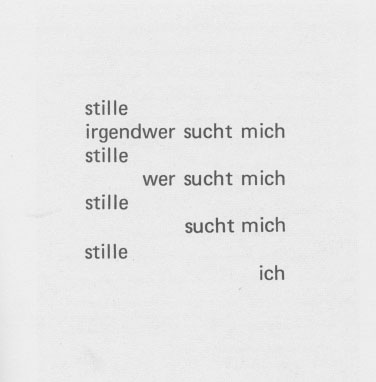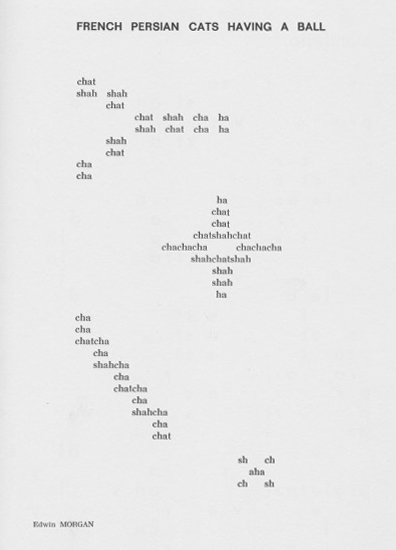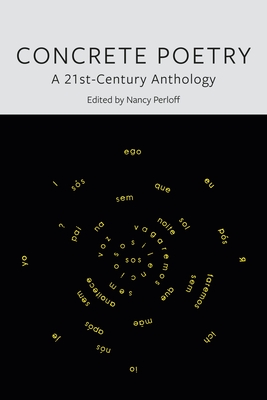A 21st Century Anthology
Edited by Nancy Perloff
Reaktion ($35)
by Richard Kostelanetz
Concrete Poetry has been getting critical attention since the appearance of several anthologies some sixty years ago, but Nancy Perloff wants to examine its stars more closely in her new anthology. She correctly notes that these poets were reflecting earlier Concrete Art as defined by the Dutch artist/writer Theo van Doesburg in 1930—a definition Perloff’s summarizes as, “the building up of painting with purely plastic elements (surfaces and colours) that exclude lyricism, drama and symbolism.” Thus concrete poems at their purest are, simply, arrays of linguistic material apart from familiar syntax and horizontal configurations.
Perloff’s book concentrates initially on the purposes and careers of poets from Brazil and the German-speaking countries of Switzerland, Austria, and Germany; later chapters cover countries such as United Kingdom, Japan, and “United States and Canada.” Surveying poetry by country seems old-fashioned in the 21st century, especially when talking about word-artists who, like the Concretists, traveled greatly and sometimes wrote in tongues other than their mother’s.
A major problem with earlier anthologies of concrete poetry is that many of the best examples appear to be visual poems, which defines language structures visually enhanced to a higher degree than the familiar poetic form of a single typeface in horizontal lines. Others appear to be sound poems that are meant to be declaimed for an acoustic experience unavailable from merely seeing the text.
Though these distinctions seem clear and simple, Perloff is confused when she writes, “Today we understand visual poetry as a larger category that subsumes concretism.” If subsumes means includes or absorbs, this is askew. As Dick Higgins and Bob Grumman have separately shown, visual poetry has its own tradition, one that intersected with concretism but did not define it. Likewise sound poetry. Perloff further blurs the issue when she states: “I would argue that visual poetry departs from concrete poetry in its tendency to combine typewriter text with imagery and computer graphics.” Nope, most visual poetry has used handwriting, traditional typefaces, letrasets, and then computer-generated typefaces.
Most of the poems in Concrete Poetry fill a full page (and sometimes two). Under each is Perloff’s critical gloss, never more than a few sentences long, and often brilliant, though in disconcertingly microscopic type. Regarding the cover image by the Brazilian concrete poet Agusto da Campos, which in truth is more of a visual poem, she writes: “Opening with the personal pronoun, “I,” in eight languages, on the outermost circle of text, the poem reads from exterior to interior until it arrives on the acronym ‘sos’ at the centre. The text contemplates the darkness and the mystery of the afterlife, using multiple languages to suggest that we all confront it together.”
Likewise visual is a poem by Gerhard Rühm, a Viennese who has lived mostly in Germany:

Perloff states: “This eerie poem begins with the German word for silence. A dialectic ensues between statement and question, always surrounded by ‘silence.’ First, ‘someone is looking for me’ (statement), then ‘who is looking for me’ (question), then a pared-down ‘looking for me’ (like an echo, could be a statement or a question), ending only with ‘ich.’ I cannot be found, Rühm seems to say, and so the silence reigns. The spatial division of the text enhances the mystery.” One might quibble as to whether the “spatial division” is actually a visual enhancement, but no matter.
Consider also Perloff’s gloss to “French Persian Cats Having a Ball,” a more purely concrete poem by the Scottish writer Edwin Morgan:

“Morgan’s comical French Persian Cats explores repetition by combining the French word for cat (chat pronounced ‘sha’) with a completely unrelated word, shah, which conveys the ‘Persian’ reference. He plays these homophones against the English word ‘chacha,’ which looks similar but differs in pronunciation. Intermittently, he inserts ‘ha’ for humour and virtuosity.” Bingo.
These glosses by Perloff set a new higher standard for the critical reading of avant-garde poetry, whether concrete or visual. The two pioneering critics of avant-garde poetry, Dick Higgins and Bob Grumman, would have loved them, as do I.
Click here to purchase this book at your local independent bookstore
Rain Taxi Online Edition Summer 2022 | © Rain Taxi, Inc. 2022


